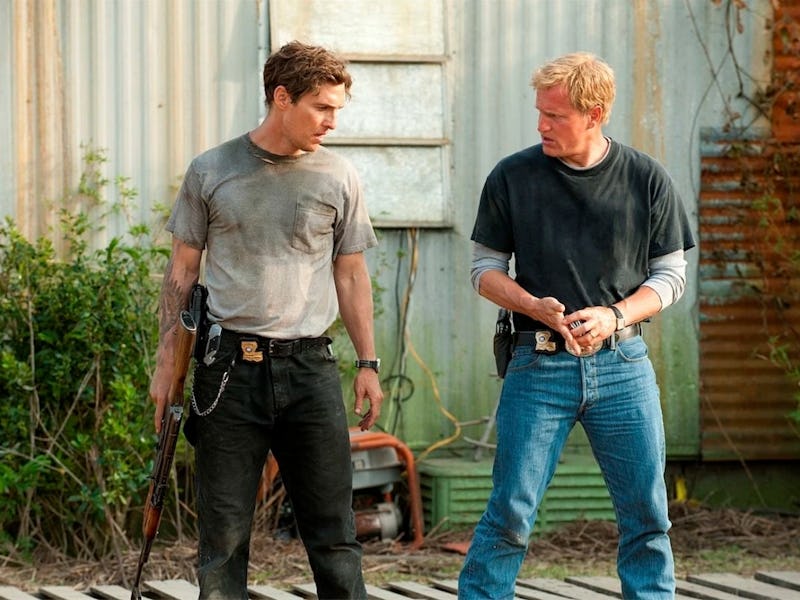It’s Been 10 Years, and Still No Show Has Tackled Cosmic Horror Like True Detective
Going downhill is the not-so-secret fate of all HBO franchises.

It’s rare to see Hollywood produce good cosmic horror. It has limited appeal compared to zombies and slashers — indescribable monsters and impossible shapes are hard to translate to a visual medium, and the genre’s Cthulhuisation makes creators reduce its mad scope to “looking at a really big squid drives someone, usually an old-timey private detective, insane.” With H.P. Lovecraft’s iconic monster now seen everywhere from children’s books to cheese commercials, trying to tell a fresh cosmic horror story can be like trying to break new ground in sci-fi with a tale about space wizards.
True Detective’s solution was to leave the horror pulsing in the background of a crime procedural and character study. When detectives Martin Hart (Woody Harrelson) and Rustin Cohle (Matthew McConaughey) are assigned the case of a murdered woman whose corpse has been desecrated with deer antlers and a spiral symbol, it’s clear this isn’t some mundane crime of passion. Their investigation uncovers hints of a conspiracy that goes all the way to Louisiana’s highest offices, but True Detective is a slow-burn just as interested in getting inside its heroes’ heads.
Jumping between their initial 1995 investigation and a 2012 follow-up that reveals they’d overlooked the true culprit, their work is complicated by a figure known as the Yellow King and a mysterious place called Carcosa, both referenced by suspects in hushed tones. Marty and Rust scour Louisiana’s backwater churches, brothels, and drug dens, but definitive answers elude them.
What does become clear is that our heroes aren’t well-adjusted men. Marty, the affable family man, is a serial philanderer, and his pleasant persona occasionally melts into terrifying acts of domestic violence. Rust is level-headed, but his tendency to philosophize on how collective self-extinction offers our only true escape from the bizarre confines of sentience is just the capstone to his cold, off-putting personality.
Regardless, they make for a compelling pair of anti-buddy cops, and that we continue to root for Louisiana’s saddest boys is a sneaky commentary on the crime genre. While it gets lost among the creepiness and navel-gazing, True Detective remains an unusually blunt example of policemen abusing their authority for personal gain, their career, or the sheer hell of it. Did years of seeing humanity at its worst bring out their darkness, or does the job attract maladjusted weirdos and petty tyrants?
Rust isn’t someone you want to crack open a cold one with.
But it’s only in the finale, “Form and Void,” where the show’s horror elements enjoy the spotlight. Anything vaguely spooky and misanthropic tends to be labeled Lovecraftian, and a backwoods cult of incestual hillbillies certainly has roots in his ideas (and biases). But True Detective owes its strongest imagery to Robert W. Chambers’ influentially ambiguous The King in Yellow, and fittingly, the episode leaves it unclear whether Rust and Marty were dealing with an otherworldly interloper or just some meth-addled loons.
As Rust hunts the killer through the bizarre backwoods labyrinth that is Carcosa, the man sees and says things he shouldn’t be capable of, an unsettling stretch that ends in Rust getting a brief glimpse of the cosmic void. In the end, though, the killer is mortal. Was he taking orders from a higher power, or was Rust’s chemically-addled brain just hallucinating again?
We never find out, nor do we learn the full extent or purpose of the murderous cabal. The loose ends disappointed some viewers, but they’re a strength of True Detective’s take on cosmic horror. Rust and Marty caught a tiny glimpse of something strange and terrifying, and now they have to live with it.
Some fans also objected to Rust seeing a glimmer of optimism after eight hours of dire philosophizing, but as Bloody Disgusting pointed out, that upbeat ending is true to both Chambers’ work and Rust himself, who, despite all his lectures on life’s pointlessness, never stopped trying to catch the killer. That careful balance between horror and awe is perhaps True Detective’s most impressive accomplishment.
Either way, it’s a bad sign when you find this in the suspect’s lair.
It’s been chasing that high ever since. After Season 1 director Cary Joji Fukunaga moved on, creator and writer Nic Pizzolatto struggled to click with his new collaborators in Season 2, while the fine but conventional Season 3 saw HBO insist Pizzolatto work with other writers, moving True Detective even further away from its weird auteur roots.
After True Detective’s second and third seasons excised the touches of cosmic horror that had been carefully woven into Season 1, True Detective: Night Country was called a return to form for HBO’s detective franchise. Night Country had its moments, but felt more like an unusually grisly X-Files episode. The connections it teased to Season 1 — commentary on its hyper-masculine worldview at best, empty franchise building at worst — never paid off, as the ending abruptly and unconvincingly switched gears to, as Vox’s Aja Romano called it, “a hamfisted Me Too revenge plot.” Its approach to horror was jump scares and creepy music, not hints that we’re all just tricking ourselves into shambling through an indifferent universe.
Issa López conceived of Night Country as a standalone series before it was crammed into the Detective-verse, and trying to be what it was never envisioned as exposed its cracks. Now, a decade later, cosmic horror continues to be an underserved genre. It’s niche, and it’s difficult to make scary without being vague or dour. But the blueprint is still there, for anyone willing to go back down the spiral.